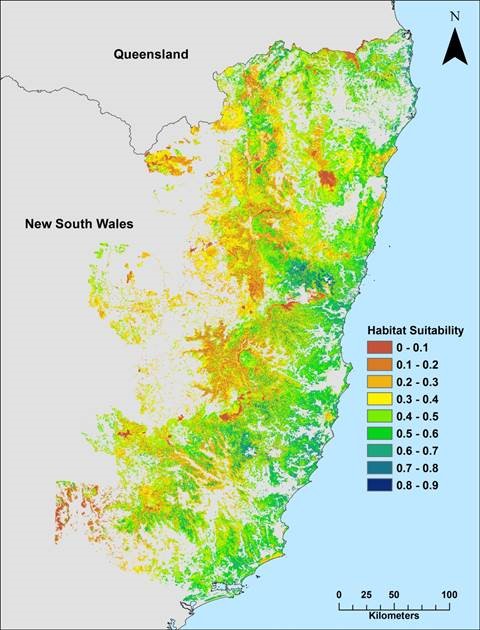Modelling koala habitat
The Predictive Koala Habitat Model was developed as the final stage of the koala mapping program. The model produces a map of koala habitat in north-eastern NSW by using environmental variables which are correlated with koala records, such as vegetation, soil type and climate. The maps will be used to more accurately identify koala habitat in private and public native forests in NSW.
The Predictive Koala Habitat Model (PDF 4.2MB) was developed in partnership with the Department of Industry Forest Science Unit.
The model produces 2 fine-scale maps (250-metre grid cell), which display koala habitat in forests in north-eastern NSW, for elevations above and below 500 metres.
Habitat suitability was modelled based on the relationship between:
- koala records, and
- environmental variables that are reliable predictors of koala habitat.
To download the spatial datasets, please visit the SEED data portal.
Koalas can be difficult animals to detect. They are well-camouflaged, with large home ranges and they are found in low numbers outside the best quality habitat. Koala pellet surveys have been shown to be unreliable indicators of koala occupancy, due to variations in how easy they are to detect and the rates the pellets decay.
A predictive model is an important resource to help guide koala management, as it uses environmental variables that influence habitat suitability and can be extrapolated to areas not previously surveyed.
The field validation undertaken as part of the development and refinement of the model showed that it is a reliable predictor of both koala occupancy and habitat quality. Field validation of the model output showed a linear increase in estimated koala occupancy with higher model output values. Similarly, the model output was correlated positively with the site-based habitat quality index.
The model output also provided a better fit to estimated koala occupancy than the site-based habitat quality index, probably because the model considers many environmental variables simultaneously, rather than just browse species.
The model uses 14 predictor variables that reflect vegetation productivity, soils, forest type, topography, climate and frequency of wildfire. These variables were chosen for their potential influence on koala habitat suitability, as well as their robustness as data-layers for modelling. The full list of variables is in the report (PDF 4.2MB).
A total of 30 variables were considered for their potential influence on koala habitat suitability. Some variables were ultimately removed because either they were highly correlated with other variables (e.g. an index of primary productivity (NDVI) was correlated with Foliage Projective Cover, so NDVI was removed to avoid bias), or because they did not make ecological sense (e.g. areas with greater Total Nitrogen were indicated as poorer quality habitat. This is counter-intuitive and most likely due to the effect of agricultural land being excluded from the model).
Koala home ranges vary from five to 50 hectares, depending on habitat quality and the presence of other dominant adult koalas. Koalas also wander over very large distances (up to 20 kilometres) and can sometimes be seen in areas of low quality habitat. Low quality habitat is less likely to support resident koala populations, but can be important for movement and dispersal between areas of high quality habitat. High quality habitat is expected to be more important for supporting breeding koalas.
The model was field validated using data collected at 65 sites across the NSW north coast (this is a statistically significant sample size).
Firstly, the model was validated using koala pellet searches and a new approach involving acoustic recording devices. From this extensive field work comprising more than a year’s worth of recordings, it was found that koalas were more likely to occupy areas shown in the maps to be of high habitat quality.
Secondly, the model was validated using a site habitat quality index which was based on the size and diversity of koala browse trees at each site. This validation showed that areas identified as high quality in the field were also modelled as high quality.
In addition, the model was validated across the entire study area using over 3000 koala records held in NSW BioNet, which had not been used in the production of the model. This process showed a high concentration of koala records in areas the model predicted as high quality and very few records in areas the model predicted to be poor quality.
- The EPA and Department of Industry (DoI) - Lands Forest Science Unit worked in partnership to develop the model. The model was developed and validated by a team of ecologists and modellers in the DDoIt, with assistance from external consultants.
- Floristic associations in the vegetation layer were coded for koala suitability by the Forestry Corporation of NSW and reviewed by the Office of Environment and Heritage(OEH).
- The model was reviewed by koala experts and forest ecologists from the EPA, OEH, DoI and independent experts.
The EPA will use the outputs of the koala mapping program, including the model, to inform the development of improved koala identification and protection requirements in both the new Coastal Integrated Forestry Operations Approval and the review of the Private Native Forestry Code of Practice.
